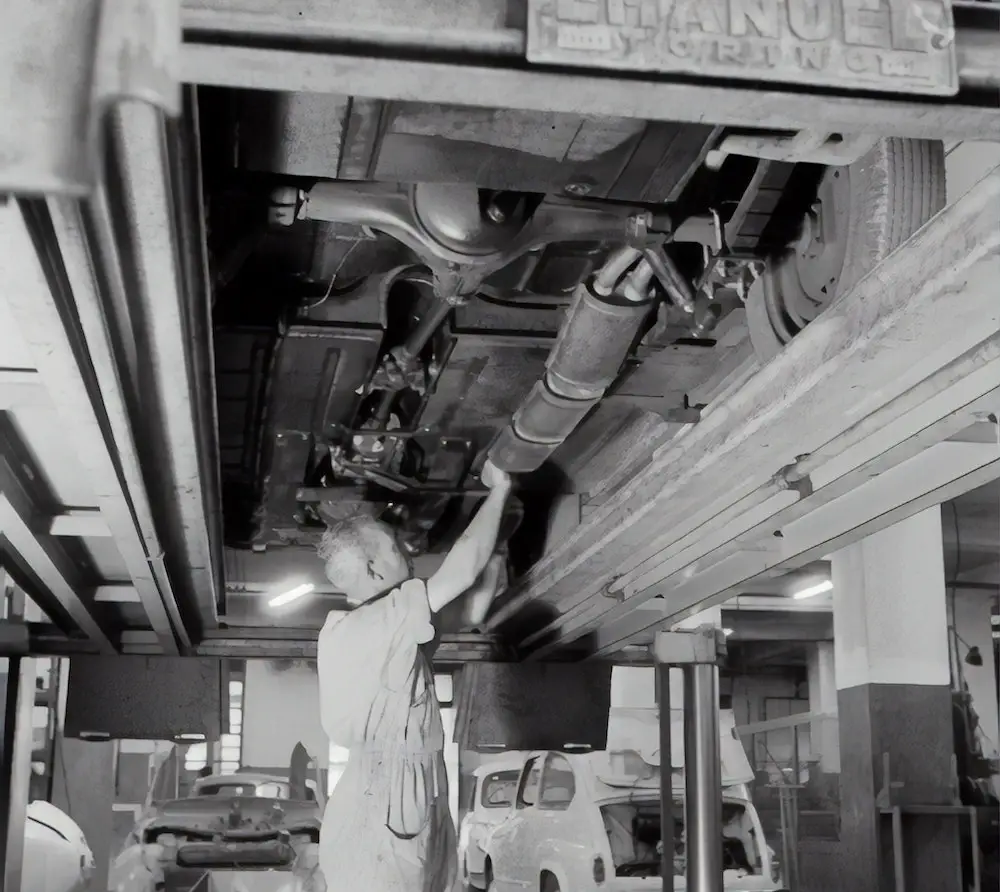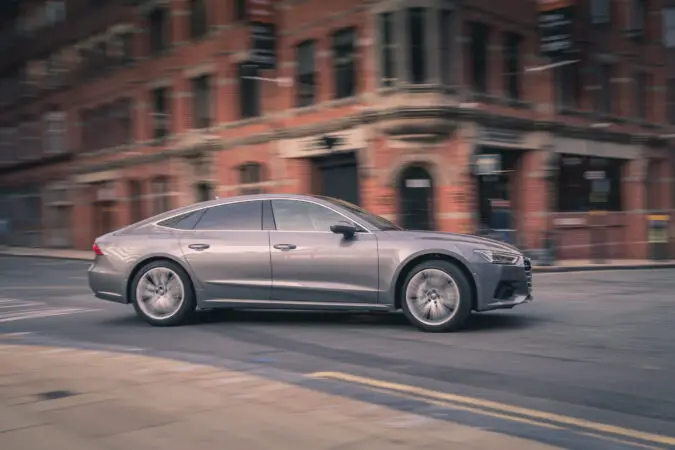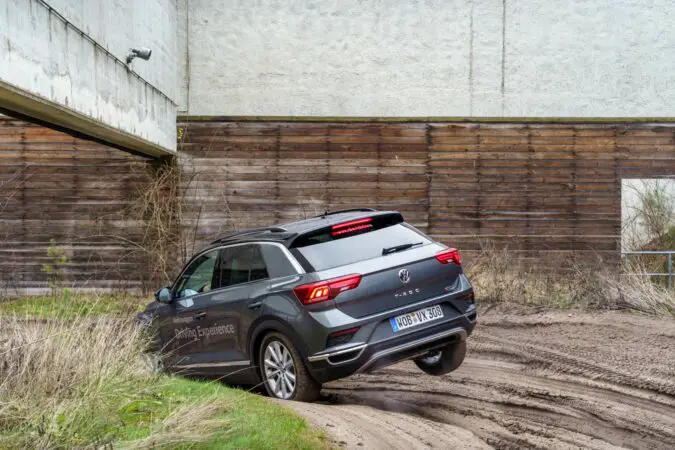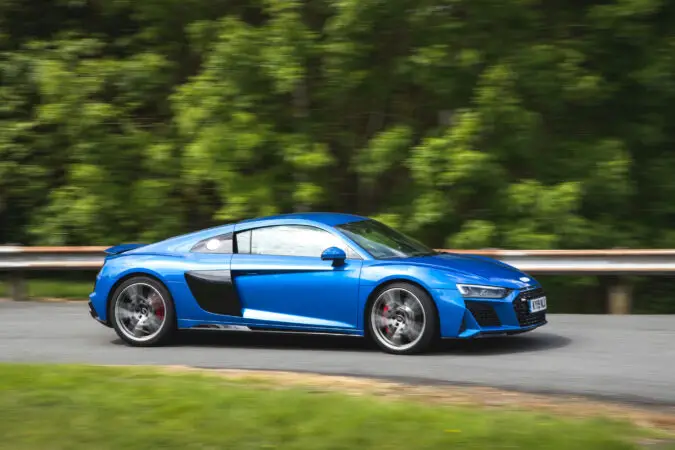We normally think of tires, brakes, and suspension as the major components that affect a car’s handling. But there’s one more component that can greatly affect a car’s handling, and that’s the differential. This post will discuss the different types of differential you’ll see in a car and how they work:
What Is A Differential?
A differential is a set of gears and shafts that controls the rotational speed of the driven wheels. They’re quite complex, so bear with us: the engine sends power to the driven wheels via a driveshaft. This shaft transfers power to the differential, and through a series of gears, the differential sends power to the wheels via two shafts – one for each wheel.
In rear-wheel-drive cars, the drive shaft runs along the length of the car to the differential at the back. You can often see the differential from underneath, which is a black metal case with three driveshafts connected to it.
In front-wheel-drive cars, the differential is at the front and usually, it isn’t visible. Meanwhile, all-wheel drive or four-wheel drive cars usually have a total of three differentials: one at the front, the middle, and at the back of the car. But why do cars need a differential?
It all has to do with cornering. When the car turns into a corner, the rotation speed between the inside and outside wheels has to be different. For example, if you’re turning right, the left wheels (outside wheels) will have to rotate faster than the right wheels (inside wheels) since it has to cover more distance.
This isn’t a problem for the non-driven wheels. However, the driven wheels are interconnected. Without a differential, they will rotate at the same speed but the inside wheels will have to slip to accomplish the turn. This isn’t comfortable for the driver and can induce wear on components including the tires.
Hence the need for a differential; the set of gears will allow the wheels to rotate at different speeds eliminating the slip. There are four types of differential, and we start with the open differential:
Types Of Differential: Open Differential
The first and most common type of differential is the open differential. This is the differential you’ll see in most cars, especially front-wheel-drive and rear-wheel-drive cars. Here’s how they work:
Essentially, at the end of the drive shaft is a pinion gear that transfers power to the ring gear. A spider gear is attached to the ring gear, which connects to a couple of side gears on the shafts that are connected to the wheels.
When the car is going straight, the spider gear will simply rotate along with the ring gear. This will rotate the side gears – and ultimately the wheels – at the same speed.
When the car turns, the spider gear will spin in the appropriate direction to allow the outside wheels to rotate faster. This allows the car to make a turn without slipping to achieve the turn, making the driving experience smoother for the driver.
Note that there might be slight variations in the construction, depending on the manufacturer. But they all work in essentially the same way.
Pros & Cons
The pros of an open differential are pretty straightforward:
- It’s relatively simple, so they’re cost-effective.
- Prevents wheel slip during cornering and makes the driving experience smoother.
- Power loss is minimal.
The downside of an open differential is that it always splits power and torque equally between the wheels on the axle. Additionally, the maximum amount of torque it can deliver to the wheels depends on how much the wheel with the least traction can handle.
A common misconception about open differentials is that they will send more power to the wheel with the least resistance. However, this isn’t true, but it does appear so in certain conditions.
To explain this further, consider the following scenario: let’s say you’re offroading and the left wheel is firmly on the ground, while the right wheel is hanging and doesn’t have any traction. For the sake of simplicity, let’s say the right wheel can only handle 50lb-ft of torque.
This means the left wheel can also only get a maximum of 50lb-ft of torque. In many cases, this wouldn’t be enough for the left wheel to overcome the resistance and rotate. The right wheel will spin since it has less resistance, but the left wheel will remain stationary, appearing as if it’s not getting any power.
Bottom line, they’re not great for offroading. This is where a locking differential comes in:
Types Of Differential: Locking Differential
As the name suggests, a locking differential means it can lock itself. There are different types, but it usually works by using a spring and weights to prevent the spider gears from spinning. Take a look:
https://www.youtube.com/watch?v=YW8Vyw-QnuA
A locking differential allows the wheels on an axle to rotate at the same speed. The differential can either do this on its own or in some cars, there’s a button or a lever for the driver to manually lock it.
But wait, isn’t the point of a differential is to allow wheels to rotate at different speeds so they can turn without slipping? Yes, but a locking differential will come in handy when you go off-roading:
Pros & Cons
When you go off-roading, especially when you’re stuck and one wheel doesn’t have traction, locking the differential can help you get out of this sticky situation.
A locking differential forces the wheels to spin at the same rate. This means the wheel with traction will spin as fast as the wheel with less traction. This will allow the car to put down more power and break free. Here’s a look at how it works:
This is why you’ll see locking differentials mostly in off-road-oriented cars since there’s no need for a locking differential on the road. Most entry-level off-roaders will only have a rear-locking differential.
However, higher-end ones with an all-wheel drive or four-wheel drive system may have a front and center locking differential as well. Locking the center differential is useful if both wheels on an axle get stuck.
The downside is of course a higher production cost, making them more expensive to buy. Maintenance is likely to be more expensive as well. Additionally, a locking differential still splits power equally and the car can’t send more power and torque to an individual wheel.
Another Type: Welded Differential
This isn’t a type of locking differential per se but we can’t talk about differentials without mentioning them. A welded differential is a differential that has been welded to force the wheels to spin at the same rate in all conditions at all times. Think of it as a locking differential but permanent.
With a welded differential, the inside wheel will break traction and slip since it has to keep up with the speed of the outside wheel. Not terribly comfortable, and can cause excessive tire wear, which is why you don’t see them in road cars.
Wait, why would you want this then? Simple: drifting. With an open differential, initiating a drift is usually a bit more difficult since it will prevent slips on the inside wheel. And when you want to drift (and to learn how to drift a car), you actually want the wheels to slip and break traction.
A welded differential will force the inner wheel to match the rotation of the outside wheel. This forces the inner wheel to slip, lose traction and makes it easier to initiate a drift.
It also makes it easier to maintain the drift. With an open differential, one wheel will remain stationary during the drift, essentially dragging on the road and stopping the drift. This can also affect the car’s balance.
Meanwhile, a welded differential will force both wheels to spin no matter what, meaning the rear wheels will continue to slip. This keeps the car in balance and makes it easier to maintain the drift.
As mentioned, you won’t find welded differentials in road cars. Instead, you’ll find this mostly in drift cars. And it’s a budget-friendly way for those who want to make their car more drift-friendly. With that out of the way, let’s get onto other types of differential:
Types Of Differential: Limited-Slip Differential
The reason why it’s called a limited-slip differential or an LSD is that the differential limits the amount of slip that occurs on the wheel with less traction.
There are several types of LSDs, but they all aim for the same goal: to limit slip and make sure the wheel with the most traction gets the power it needs. In principle, they’re quite similar to a locking differential in terms of what they’re trying to achieve.
However, an LSD is a more dynamic – and complicated – solution since it can still allow the wheels to rotate at different speeds. Whereas a locking differential cannot do that.
Additionally, unlike a locking differential, some types of LSDs can transfer more power to an individual wheel. Here are the different types of LSDs, along with their benefits and downsides:
1. Mechanical Clutch-Type LSD
A mechanical clutch-type LSD is similar in construction to an open differential. The main difference is that it has a pressure ring/shaft in-between the side gears and clutch packs sitting on either side of the axle.
Under acceleration, the pressure ring will move downwards to push the differential housing. This in turn presses the clutch packs on either side of the axle and locks them together. As a result, you now have equal amounts of torque on both wheels and essentially have a locking differential.
When the car corners, the clutch pack on the inner wheel will slide to allow the wheel to rotate at a slower rate than the outside wheel. This will also let the differential channel more power to the outside wheel. We’ll let Jason Fenske from Engineering Explained take over:
The clutch-type LSD comes as either a one-way, two-way, or 1.5-way. One-way means the LSD can only lock the axle during acceleration. While the two-way means the LSD can lock the axle during braking, which may help in certain situations.
Meanwhile, the 1.5-way can also lock the axle during both acceleration and deceleration as way, but with less locking force during deceleration which may be beneficial.
Additionally, a clutch-type LSD may also have electronic controls. This means the computer can lock the differential before slip or loss of traction before it occurs if the computer deems it necessary. The main downside to the clutch-type LSD is that it will require regular maintenance, and repairing them is not cheap.
2. Viscous Limited Slip Differential
A viscous limited-slip differential or VLSD uses a thick liquid instead of clutch packs for its operation. However, it does still use clutch plates within it.
The simplest way to explain this is that the differential has clutch plates on either side of the axle shaft. These clutch plates are submerged in differential liquid. Under normal conditions, the differential housing will rotate at the same speed as the axle shaft.
The liquid comes into play when one wheel loses traction. For example, if the right wheel loses traction, then it’s going to spin faster and the differential housing to spin faster along with it.
However, the left axle and its clutch packs are still spinning at a slower rate than the housing since the left wheel has more traction and resistance. This builds up the resistance between the clutch plates and the liquid inside the left-side of the differential housing.
This allows the left wheel to receive more torque, forcing it to spin faster and allowing the driver to find more traction.
The downside of VLSD is that it’s reactive and cannot anticipate a slip. This is also a problem with the clutch-pack LSD, but you can use electronic controls in them, whereas you can’t have electronic controls for VLSD.
Another problem is that it cannot fully lock up, as the liquid is unable to provide absolute resistance. Additionally, while the system doesn’t require regular maintenance (not to mention knowing how to reset maintenance light on Toyota Tacoma), the liquid thins over time due to heat, making the system less efficient over time.
And finally, a problem with both the clutch-type and VLSD is that it may create over or understeer during high-speed cornering. This is due to the differential misinterpreting the faster outer wheel losing traction. In reality, it’s often the inner wheel that loses traction during high-speed cornering.
3. Torsen LSD
A Torsen LSD works by using a set of worm gears and spur gears or worm wheels. The worm wheels are what enable this system to transfer power individually. Here’s how it works:
In a nutshell, the worm wheels work as a locking mechanism when one wheel loses traction. When one wheel is spinning faster due to traction loss, the worm wheels will force the wheels on the other side to rotate faster as well.
The Torsen system is essentially still a reactive system, just like a mechanical clutch-plate type and VLSD. However, it’s far more responsive than the other systems.
Types Of Differential: Torque Vectoring Differential
Torque vectoring is essentially a more complex variant of an electronic clutch-type LSD. As mentioned, the clutch-type LSD uses clutch packs to lock and divert power to an individual wheel. This system is reactive, but it can be electronically controlled by using sensors and actuators.
The torque vectoring system takes this further by utilizing more sensors and computing power to predict and react when they will need to lock the axle, as well as where to send the power.
The system can almost infinitely adjust the amount of locking and power transfer to each wheel. In some cars, it can divert 100% of the engine’s power to an individual wheel.
Additionally, the system also uses something known as brake torque. In simple terms, the car can individually engage the brake on a single wheel. For example, if you’re doing a right-hand turn, the system will brake the right wheel to slow down its rotation.
At the same time, it engages the clutch pack of the outside wheel to send more power to it. Allowing the outer wheel to rotate faster than the inside wheel, which is what it needs to do when turning. The torque vectoring system is very complex, so we recommend watching this video from Donut Media to get a better understanding:
The gist of it is that torque vectoring works very similarly to a clutch-pack LSD. The difference is that it has more sensors and electronics, which allows the system to be active rather than reactive to driving conditions and driver setup.
Pros & Cons
The advantage is of course better handling performance in almost any condition. Additionally, since the system is electronically-controlled, the amount of lock and slip can vary depending on how much the engineers design them to be.
This means the system can also change the way it behaves depending on the driver’s preference. Cars that have a torque vectoring system usually have driving modes, such as Comfort, Sport, or Race. The differential can behave differently depending on which setting the driver chooses.
For example, in Comfort mode, the system will behave like any normal open differential. But in Sport or Race mode, the system can lock the differential, allowing the car to eliminate over or understeer. As a result, the car can corner faster and produce better lap times.
Of course, this system is not cheap. Lexus charges around $1,250 for their RC-F to be fitted with torque vectoring. And with so many sensors and electronics, repairs are not going to be cheap either.
Types Of Differential: Which Differential System Is Best?
The best is obviously the torque-vectoring system. It combines all the good things about open and LSD systems, but with smarter electronic controls to anticipate a variety of driving conditions and driver preferences.
However, this system is very complex and therefore expensive. So, you won’t find this apart from in performance cars and maybe high-end all-wheel drive cars such as Audi’s offerings with Quattro.
Of course, most cars don’t need a fancy torque vectoring system. The open differential gets the job done. In most cases, you probably won’t notice the shortcomings of an open differential. And since it’s so much simpler, it’s going to require a lot less maintenance and be cheaper to maintain as well.
However, if you’re driving a truck or an SUV and you like to go offroad, then you will benefit greatly from a locking differential. The shortcoming of the system is that it doesn’t engage at higher speeds. But you only need the locking mechanism when you’re stuck.
Higher performance cars will benefit from using an LSD, especially if you push the car such as during a track day. LSDs can help the car to corner faster, although this often depends on the setup of the LSD itself as well.
Unlike torque vectoring, you can buy aftermarket LSDs as they don’t require sensor installation and software alterations. This makes them simpler and cheaper to install.
Finally, if you want to go drifting on a budget, a locked or welded differential is the way to go. Welded differentials make drifting easier to maintain, and ultimately make it safer as well. Keep in mind that you shouldn’t drift on public roads, for the sake of your and everyone else’s safety.
Types Of Differential: In Conclusion…
So, in conclusion, there are four types of differential: open, locking, LSD, and torque-vectoring. As well as the welded differential, but it’s not used in road cars, and manufacturers don’t offer them.
LSDs can be broken down into several more types, depending on how they work. There’s the mechanical clutch-type LSD which uses clutch packs to lock the differential. And the viscous limited-slip differential or VLSD uses a viscous liquid to engage the system.
The clutch-type system also has an electronic variant, often referred to as an electronic differential. It essentially works the same way but uses sensors and electronic controls to engage the system, rather than relying on the system to engage mechanically.
And finally, there’s the torque vectoring differential, which is essentially a fancier and more complex version of an electronic differential. It works largely the same way, but it uses more sensors and actuators, allowing the system to transfer power more intelligently.
Now you know about the different types of differential, as well as their benefits and downsides. Hopefully, this has been a helpful article, or at least, now you know more interesting facts to bring up during an awkward first date.






